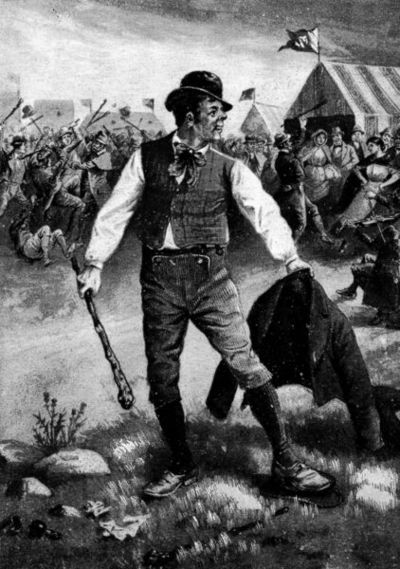Annotation:Shanavest and Caravat (1)
X:1 T:Shanavest and Caravat [1] L:1/8 M:2/4 Q:"With spirit" S:Joyce – Old Irish Folk Music and Songs (1909, No. 264) Z:AK/Fiddler’s Companion K:D A|d>ddd|cAFG|A>BcA|d2 d A|d2 f>g| a2 fa|gfed|c2 A>A|d2 f>g|a2 fa| gfed|e>fga|fddd|cAFG|ABc>A|d2d2||

The groups grew out of agrarian unrest. The Caravats were primarily a Whiteboy organization who recruited the poor in autonomous local gangs. They pitted themselves against the middle class with intense hostility, and had an internal structure that rewarded loyalty and solidarity. A recorded version of the Caravat oath goes:
To be true to each other and our friends, to attend all meetings when warned, no cause to excuse absence but sickness, of which sufficient proof must be given, to keep all secrets, to suffer until death rather than betray each other or whatsoever may be seen or heard of our cause, and to stand by each other at all fairs and patrons.
The Shanavests who opposed them were a middle class anti-Whiteboy movement, who inhabited much the same geographic area as the Caravats. They rallied around the cause of Irish nationalism and condemned the Whiteboys as anti-nationalist. However, the Shanavests were smaller in number and as a consequence tended to loose out in the faction fights between the two. From 1806 to 1811 the Shanavest and Caravat conflict raged across large areas of Tipperary, Waterford, Kilkenny, Limerick and Cork.. Its violence was unprecedented with clashes between the two groups often involving firearms and frequent deaths. At the end the conflict was reduced to faction fights, gang fights, with allegiance to a political cause more and more a transparency.
Faction fighting was not only between rival gangs. In fact, the incident that produced the greatest death toll, with over 200 people killed and several hundred injured occurred between clan groups in a faction fight at Ballyveigh Strand, County Kerry in June, 1834. A 19thcentury account goes:
It had been rumored that a faction fight was going to happen. On 24th of June, 1834, on the occasion of the Ballyeagh strand horse races on St. Johns Day, the Lawlors/Mulvihills encountered the Cooleens. The battle was fought with special sticks called Blackthorne sticks or cudgels. Some were weighted with lead and were not used free swinging but were held in the middle to protect the elbow. An estimated 1,200 of the Cooleens crossed the Feale in boats from the north and were then in what was considered Mulvihill/Lawlor territory and was in itself considered provocative. The Cooleens attacked the Mulville/Lawlor people who were generally imbibing with poteen and whskey. The invaders came forward in lines with about 20 women on the sides with aprons full of stones. The authorities tried to stop them from coming but were unsuccessful. At first the Cooleens got the upper hand since half of their adversaries were still in their tents having a good time with their whiskey. Gradually the Mulville/Lawlor faction got organized and about 1,500 of them counter-attacked. They drove the invaders back into the water and won the day.
P.W. Joyce thinks it likely, from the character of the tune, that it was used as a march. Bayard (1981) begs comparison of this tune with "The Blackbird," to which he sees a close relationship, believing them to be different segments of the same tune family.

